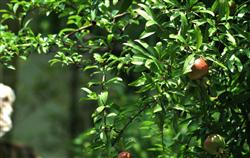Pomegranate tree planting: how to manage pomegranate before picking?

Now the pomegranate is about to mature, how to manage it well before picking? If there are any netizens who can introduce the management of pomegranate before harvest, you can refer to the following methods (for reference): pomegranate tree thinning, heart-picking: removing the overgrown branches, erect branches, dense branches and slender branches in the canopy. Keep the inside of the crown ventilated and transparent. The exuberant shoots that have not stopped growing but need to be preserved for the purpose of cultivating tree shape are gently plucked to reduce nutrient consumption, make branches grow fully and healthily, and ensure safe overwintering. To promote pomegranate coloring: bagging fruits were bagged in time from late August to early September, and the bagging time was 20-25 days before harvest. Bagging was the most beneficial to fruit coloring and sugar content improvement. Bag removal should be carried out after 4 pm on cloudy or sunny days. If you are covering a double bag, remove the outer bag first and go to the inner bag after an interval of 3 to 5 days. To remove the bag, you should pay attention to the weather and beware of pericarp burns caused by high temperature and strong sunlight, reducing the value of the fruit. After removing the bag, the fruit colorant should be sprayed in time to promote fruit coloring. Picking leaves and turning fruits is an auxiliary measure to promote pomegranate coloring. When picking leaves, remove the bag, remove the leaves that block the direct sunlight of the fruit, and remove the twigs that block the fruit. Turn the fruit so that the shady side of the fruit can be seen to ensure that the whole fruit is colored evenly. The pedicels in some parts of the fruit are short and thick and cannot be rotated. By means of pulling, distinguishing and hanging, the position of the fruit mother branch can be turned so that the back of the fruit can be seen and colored. Laying reflective film is also an important measure to promote pomegranate coloring. From early September to before fruit harvest, applying silver reflective film under the pomegranate tree or in the tree row can obviously improve the light intensity of the inner chamber and middle and lower part of the crown, and increase the coloring area and quality of the fruit. Prevention of pomegranate cracking: 10-15 days before harvest, watering should be strictly controlled, especially irregularly irrigated orchards in dry mountains, hills and plains, and should be harvested in time after a long drought and rain. Spraying 25 mg / L gibberellin in late August and early September can reduce fruit cracking by more than 30%. Cultivating pomegranate tree potential to promote flower bud differentiation: pomegranate fruit quantity is large, or soil fertilizer supply is insufficient, and the harm of diseases and insect pests is serious, which is easy to cause premature senescence of pomegranate trees, while mid-late September is the second peak of flower bud differentiation of pomegranate trees in the same year. Flower bud differentiation in this period directly affects the yield of the second year. Therefore, it is important to take measures to promote the healthy growth of trees. It is necessary to apply quick-acting fertilizer in time, pay attention to the combination of nitrogen and phosphorus, apply potassium appropriately, apply 0.25 kg of urea and calcium superphosphate each, and spray 0.2%-0.35% organic potassium fertilizer or multi-element micro-fertilizer on the leaf. Pomegranate trees control fertilizer and water: keep the trees growing normally. In the management of fertilizer and water, we should achieve "front promotion and post control", not only to ensure the normal growth of trees for all kinds of nutrients, but also to prevent later growth. Therefore, nitrogen fertilizer is the main fertilizer in the early stage, with phosphorus and potassium fertilizer, timely and appropriate irrigation, while in the later stage, phosphorus and potassium fertilizer is the main fertilizer to reduce the number of irrigation. For prosperous pomegranate trees, 40% ethephon 2000-3000 times can be sprayed after fruit harvest to regulate tree growth. Pomegranate pomegranate pest control: the main control targets in this period are peach borer, peach heart borer, stem window moth, diamondback moth, Chinese golden belt moth, golden caterpillar, dry rot, fruit rot, brown spot and other diseases. Control methods: cut the insect tip, pick the fruit, bury it deeply or burn it, and kill the pupated larvae on the tree trunk; spray 40% mancozeb 500x solution or 40% methyl thiophanate 800x solution or 40% carbendazim glue suspension 500x solution plus 50% crystal trichlorfon 1000 times solution to control the disease and control pests. The use of toxic pesticides should be reduced as much as possible in the later stage. Click to get more pomegranate tree planting techniques click to get more fruit planting techniques
Related
- Moge, come on! The staff of the peasant association in the producing area of cantaloupe were frightened when the crowd gathered.
- Causes and Solutions of low Fruit setting rate of Apple
- Symptoms and control measures of passion fruit virus disease
- Fruit growing lesson: how do apple orchards keep high yields?
- Can you build orchards in the mountains? What are the pros and cons?
- How to manage the coloring period of Crisson grape?
- This paper introduces the processing technology of two kinds of fig products.
- How much is a month for retired teachers in rural areas by 2020?
- How can strawberry planting increase sugar content? We should pay attention to management in many aspects.
- What are the cultivation techniques on how to improve the yield of golden fruit?



